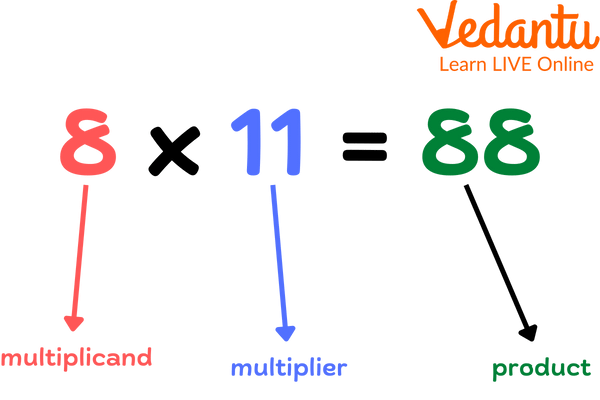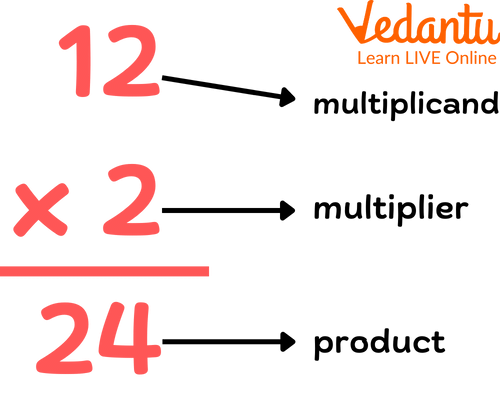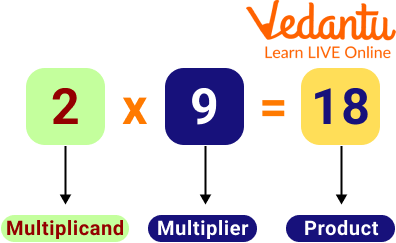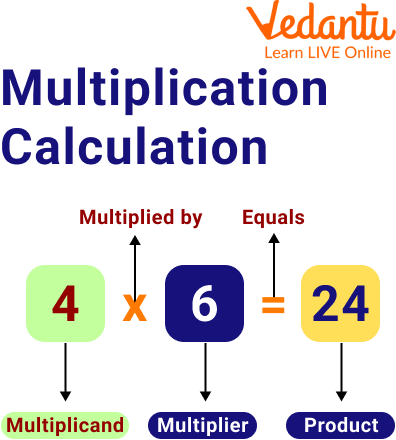




How to Identify Multiplicand and Multiplier in Word Problems
Mathematical expressions are pretty awesome. They are super logical and organised when you look into them. Every expression (Any sequence of numbers with a bunch of symbols can be called a mathematical expression) has an order, each part has a particular name.

Parts of Multiplication
When it comes to multiplication, every number used has a name. If you have guessed by now, parts of a multiplication consist of multiplicand, multiplier and product. We will learn more about these new terms Multiplicand, Multipliers and products with various multiplier examples in this article.
What is Multiplicand in Maths?
The number to be multiplied with the given number is called a multiplicand. Though it is a bit confusing, remembering multiplicand to be the number before the multiplication symbol makes it a bit easier. Let's take the example of Multiplicand below.
In the equation 4 x 5 = 20, 4 is the multiplicand or we can also say that 4 is the mathematical expression of the Multiplicand.

Multiplicand
What is Multiplier in Maths?
The number which is multiplied by the given multiplicand is called a multiplier. It is easier to remember the multiplier to be the number after the multiplication symbol to ease confusion while marking the parts of multiplication. Let's take an example of a Multiplier below.
In the equation 4 x 5 = 20, 5 is the multiplier, we can also say that 5 is the mathematical expression of the Multiplier.
A multiplier is a number that is multiplied to increase the value of the multiplicand at the end of solving an equation.

Multiplier, Multiplicand and Product
Above mentioned image shows the mathematical expression of the multiplier.
What is a Product?
The answer obtained at the end of a multiplication equation is called the product. The result obtained when a multiplicand and a multiplier are multiplied is called the product. It is important to remember that product is nothing but the increased multiplicand obtained at the end of the process of multiplication.
In the equation 4 x 5 = 20, 20 is the product.

Product
Difference between Multiplier and Multiplicand
The "factors" are often the numbers that need to be multiplied. The "multiplicand" is the number that has to be multiplied, and the "multiplier" is the number by which it is multiplied.
For example, each of the three groupings in this instance has six candies. There are therefore 3 times 6 candies, or 6 + 6 + 6, for a total of 18. The result of multiplying two numbers is the "product." The term "multiplicand" refers to the number of items in each group whereas the term "multiplier" refers to the quantity of such equal groups.
Solved Examples
1. Find the product for an expression where the multiplicand is 40 and the multiplier is 3.
Ans: The given statement can be re-written as 40 x 3 where 40 is the multiplicand and 3 is the multiplier.
To solve the expression, 40 x 3= 120.
So, the product of the given expression is 120.
2. For a given expression “50 x 2= 100”, find the parts of the multiplication.
Ans: 50 is the multiplicand.
2 is the multiplier.
100 is the product of the expression.
3. Find the product for an expression where the multiplicand is 127 and the multiplier is 7.
Ans: The given statement can be re-written as 127 x 7 where 127 is the multiplicand and 7 is the multiplier.
To solve the expression, 127 x 7= 889
So, the product of the given expression is 889.
4. For a given expression “193 x 2= 386”, find the parts of the multiplication.
Ans: 193 is the multiplicand.
2 is the multiplier.
386 is the product of the expression.
5. Find the product for an expression where the multiplicand is 39 and the multiplier is 9.
Ans: The given statement can be re-written as 39 x 9 where 39 is the multiplicand and 9 is the multiplier.
So, the product of the given expression is 39 x 9 = 351.
Practice Problems
1. Multiply 34 by 4 and identify the parts of the multiplication.
Ans: 34 x 4 = 136. 34 is the multiplicand, 4 is the multiplier, and 136 is the product.
2. Find the product for an expression where the multiplicand is 80 and the multiplier is 6.
Ans: The product of the expression is 480.
3. For a given expression “74 x 8= 592”, find the parts of the multiplication.
Ans: 74 is the multiplicand, 8 is the multiplier, and 592 is the product.
4. Multiply 89 by 6 and identify the parts of the multiplication.
Ans: 89 is the multiplicand, 6 is the multiplier and 534 is the product.
5. Find the product for an expression where the multiplicand is 72 and the multiplier is 5.
Ans: The product of the expression is 360.
Summary
Let’s brush through what we’ve learnt up until now. Multiplication has a number of parts like the multiplicand, multiplier and product. The multiplicand is the number to which another number is multiplied and whose value is observed to increase. A multiplier is a number which is multiplied by the multiplicand. The result obtained by the multiplication of multiplicand and multiplier is called the product of the multiplication. These parts are important to be identified and understood in order to ensure better application of multiplication expressions in Mathematics.
FAQs on Multiplicand and Multiplier: Definitions, Examples & Practice
1. What is multiplicand and multiplier?
The multiplicand is the number being multiplied, while the multiplier is the number by which the multiplicand is multiplied. In the equation $a \times b = c$, a is the multiplicand, b is the multiplier, and c is the product. For example, in $6 \times 3 = 18$, 6 is the multiplicand and 3 is the multiplier.
Understanding these terms is fundamental in mathematical learning and problem-solving, which is addressed in depth through Vedantu's interactive teaching methods.
2. Which comes first, multiplier or multiplicand?
Traditionally, in mathematics, the multiplicand comes first, followed by the multiplier. For example, in $5 \times 4$, 5 is the multiplicand and 4 is the multiplier. However, because multiplication is commutative ($a \times b = b \times a$), the order does not affect the product. In mathematical education at Vedantu, both terminology and application are taught to build strong conceptual clarity.
3. What is a multiplier of 4?
A multiplier of 4 refers to any number that, when multiplied by another number, yields a product. For example, if you multiply 4 by 7 ($4 \times 7 = 28$), then 7 is the multiplier of 4. Alternatively, numbers like 1, 2, 3, etc. can serve as multipliers with 4 to obtain different products. Vedantu offers practice problems and detailed explanations to help students master concepts of multiplication, including identifying multiplicands and multipliers.
4. What is multiplier with example?
A multiplier is a number by which another number (the multiplicand) is multiplied.
- Example: In $8 \times 6 = 48$, 6 is the multiplier and 8 is the multiplicand.
- Here, 8 is being multiplied 6 times.
5. What is the difference between multiplicand and multiplier in a multiplication sentence?
Multiplicand is the number that is being multiplied, whereas the multiplier indicates how many times the multiplicand is to be taken. For instance, in the equation $7 \times 5 = 35$,
- 7 (multiplicand) is taken
- 5 (multiplier) times
6. How do you identify the multiplicand and multiplier in word problems?
To identify the multiplicand and multiplier in word problems:
- Look for the number representing the group or item being counted repeatedly — that’s the multiplicand.
- The number indicating how many groups or the number of times an action occurs is often the multiplier.
7. Why is understanding the roles of multiplicand and multiplier important in mathematics?
Understanding the differences between multiplicand and multiplier is crucial because it helps students:
- Accurately interpret multiplication operations
- Break down complex problems into manageable steps
- Improve clarity in mathematical communication
8. Can the roles of multiplicand and multiplier be reversed in multiplication?
Yes, because multiplication is a commutative operation, the roles of multiplicand and multiplier can be reversed without changing the result. In $9 \times 2 = 18$, 9 is the multiplicand and 2 is the multiplier; in $2 \times 9 = 18$, 2 becomes the multiplicand and 9 the multiplier. This property is emphasized in Vedantu’s interactive sessions to help students understand the flexibility of multiplication in mathematics.
9. How are multiplicand and multiplier used in multi-digit multiplication methods?
In multi-digit multiplication, the multiplicand is usually written on top and the multiplier below it in vertical format. Each digit of the multiplier multiplies the entire multiplicand, step by step, and the results are added for a final product. For example:
To multiply 23 (multiplicand) by 4 (multiplier):
Step 1: $4 \times 3 = 12$
Step 2: $4 \times 20 = 80$
Add $80 + 12 = 92$
Vedantu offers comprehensive lessons and practice sheets for mastering multi-digit multiplication strategies.
10. How does Vedantu help students master concepts of multiplicand and multiplier?
Vedantu supports students in mastering multiplicand and multiplier through:
- Live interactive classes by expert math teachers
- Personalized doubt-solving sessions
- Engaging practice worksheets and quizzes
- Real-life application problems for conceptual clarity























